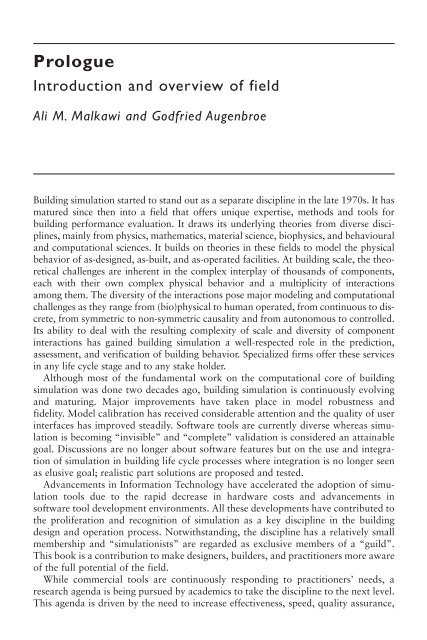Advanced Building Simulation
Advanced Building Simulation
Advanced Building Simulation
Create successful ePaper yourself
Turn your PDF publications into a flip-book with our unique Google optimized e-Paper software.
Prologue<br />
Introduction and overview of field<br />
Ali M. Malkawi and Godfried Augenbroe<br />
<strong>Building</strong> simulation started to stand out as a separate discipline in the late 1970s. It has<br />
matured since then into a field that offers unique expertise, methods and tools for<br />
building performance evaluation. It draws its underlying theories from diverse disciplines,<br />
mainly from physics, mathematics, material science, biophysics, and behavioural<br />
and computational sciences. It builds on theories in these fields to model the physical<br />
behavior of as-designed, as-built, and as-operated facilities. At building scale, the theoretical<br />
challenges are inherent in the complex interplay of thousands of components,<br />
each with their own complex physical behavior and a multiplicity of interactions<br />
among them. The diversity of the interactions pose major modeling and computational<br />
challenges as they range from (bio)physical to human operated, from continuous to discrete,<br />
from symmetric to non-symmetric causality and from autonomous to controlled.<br />
Its ability to deal with the resulting complexity of scale and diversity of component<br />
interactions has gained building simulation a well-respected role in the prediction,<br />
assessment, and verification of building behavior. Specialized firms offer these services<br />
in any life cycle stage and to any stake holder.<br />
Although most of the fundamental work on the computational core of building<br />
simulation was done two decades ago, building simulation is continuously evolving<br />
and maturing. Major improvements have taken place in model robustness and<br />
fidelity. Model calibration has received considerable attention and the quality of user<br />
interfaces has improved steadily. Software tools are currently diverse whereas simulation<br />
is becoming “invisible” and “complete” validation is considered an attainable<br />
goal. Discussions are no longer about software features but on the use and integration<br />
of simulation in building life cycle processes where integration is no longer seen<br />
as elusive goal; realistic part solutions are proposed and tested.<br />
Advancements in Information Technology have accelerated the adoption of simulation<br />
tools due to the rapid decrease in hardware costs and advancements in<br />
software tool development environments. All these developments have contributed to<br />
the proliferation and recognition of simulation as a key discipline in the building<br />
design and operation process. Notwithstanding, the discipline has a relatively small<br />
membership and “simulationists” are regarded as exclusive members of a “guild”.<br />
This book is a contribution to make designers, builders, and practitioners more aware<br />
of the full potential of the field.<br />
While commercial tools are continuously responding to practitioners’ needs, a<br />
research agenda is being pursued by academics to take the discipline to the next level.<br />
This agenda is driven by the need to increase effectiveness, speed, quality assurance,

















